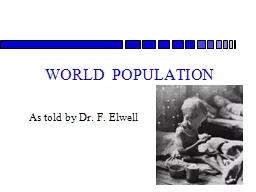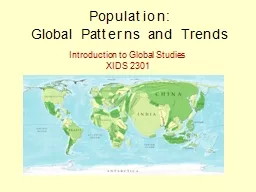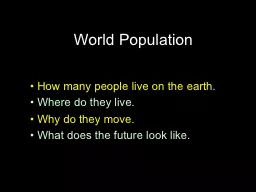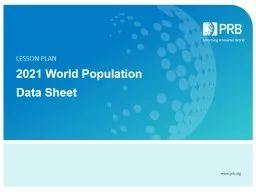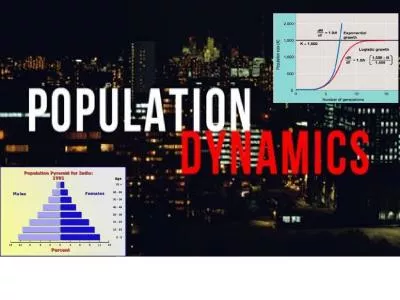PPT-WORLD POPULATION
Author : trish-goza | Published Date : 2017-04-14
As told by Dr F Elwell World Population In the six seconds it takes you to read this sentence 24 people will be added to the earths population Within an hour 11000
Presentation Embed Code
Download Presentation
Download Presentation The PPT/PDF document "WORLD POPULATION" is the property of its rightful owner. Permission is granted to download and print the materials on this website for personal, non-commercial use only, and to display it on your personal computer provided you do not modify the materials and that you retain all copyright notices contained in the materials. By downloading content from our website, you accept the terms of this agreement.
WORLD POPULATION: Transcript
As told by Dr F Elwell World Population In the six seconds it takes you to read this sentence 24 people will be added to the earths population Within an hour 11000 will be added By days end260000. Those born before 1950 are members of the first generation in history to wit ness such a doubling during their lifetime Stated otherwise more people have been added to the worlds population since 1950 than during the 4 million preceding years since 03 Population over 60 2012 919 Life expectancy at birth 2012 Total Male Female 79 Both sexes 76 Male 83 Female Neonatal mortality rate per 1000 live births 2012 11 717 Both sexes Under5 mortality rate per 1000 live births 2012 18 1324 Both sexes Mat Global Patterns and Trends. Introduction to Global Studies. XIDS 2301. Farmers protest. Food riots. http://www.nytimes.com/2008/04/18/world/americas/18food.html. The light blue line shows that between 2005 and 2007, food prices have increased by more than . population Winnipeg population Winnipeg population City of Winnipeg population Population of Winnipeg April 2016 Prepared by City of Winnipeg population Winnipeg population Winnipeg population Winnipe • How many people live on the . earth.. • Where do they . live.. • Why do they . move.. • What does the future look . like.. World Population:. 7,045,230,000. +. Where do. most people . live?. : . . AP Environmental Science . Human Population Dynamics. There are just three sources of change in population size:. Fertility. Mortality. "natural decrease" refers to population decline resulting from more deaths than births. 2) What are some things he mentions that can slow human population growth?. 3) How does increasing child survivability decrease population growth?. A . city experiences 12 deaths for each thousand people. What is the death rate (as a percentage and per thousand. Size. Increased by. Decreased by. . Calculations. r = (b – d) (i – e) . Local Population Changes. Global Population Changes. Density. What is it?. . Does the predator or the prey control it?. An interbreeding group of the . same species. living in the same general area. may be distinguished by natural or . . arbitrary boundaries. Population Density vs Dispersion. the number of individuals per unit area or volume. Sergio DellaPergolaThe Avraham Harman Institute of Contemporary JewsThe Hebrew University of JerusalemJerusalemIsraelsergioahujiacilSrgio 5llatrgola orld Wwish topulation 2019 in Arnold 5ashfsky and L is concerned with the question of whether a particular allele or genotype will become more common or less common over time in a population, and Why.. Example: . Given that the CCR5-. D. 32 allele confers immunity to HIV, will it become more frequent in the human population over time?. Data Sheet. PRB’s World Population Data Sheet . at a Glance. ACTIVITY 1. Learning Objectives. Select a country’s population characteristics using PRB’s World Population Data Sheet.. Identify countries that rank highest/lowest in a population indicator.. Most . populations . live together in clumps or patches.. Populations can grow, shrink, or remain stable. Population Dynamics. Age Structure. – proportions of individuals at various ages. Population Density. SW: discuss with their groups how estimating a population could be used in a real world situation.. Population Ecology. Measuring a population. Growth Curves. Biotic Potential vs. Environmental. Resistance.
Download Document
Here is the link to download the presentation.
"WORLD POPULATION"The content belongs to its owner. You may download and print it for personal use, without modification, and keep all copyright notices. By downloading, you agree to these terms.
Related Documents

